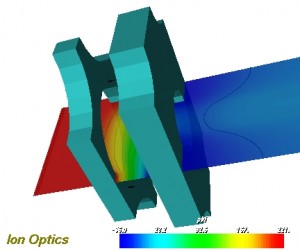 The PEPL Mission
The experimental and theoretical research program is guided by three goals:
1. To make electric propulsion (EP) devices more efficient and of better performance
2. To Understand spacecraft integration issues that could impede the widespread use of these devices on scientific, commercial, and military spacecraft
3. To identify non-propulsion applications of EP systems (e.g., plasma processing, space-plasma simulation)
The PEPL Story
"Founded in 1992, by Professor Alec Gallimore, the Plasmadynamics and Electric Propulsion Laboratory is now one of the world's leading electric propulsion research centers. The centerpiece of the laboratory is the Large Vacuum Test Facility (LVTF), 9-m long and 6-m diameter cylindrical stainless-steel clad vacuum chamber. The chamber was built, in 1961, by the Chicago Bridge and Iron Company for the Bendix Corporation. Originally named the "Space Simulation Chamber," early experiments investigated the development of Lunar Rovers (at one point the chamber floor was covered in sand for astronaut and rover lunar surface testing) and various other Apollo era research projects...
The chamber was donated to the University of Michigan in 1982 and laid relatively dormant until Professor Gallimore came to the university to turn the facility into a state-of-the-art electric propulsion laboratory. To this end, the chamber's original oil diffusion pumps have been superseded (in the 1990s) by a series of seven liquid-N2 baffled reentrant cryogenic pumps that reach a high-vacuum base pressure of 2x10-7 with a combined pumping speed of 500,000 liters-Air/sec (or 240,000 liters-Xe/sec). Initial research at PEPL, in the early 1990s, focused on arcjets, cathodes, and MPDs while work with Hall effect thrusters began in 1994. During the mid- to late-nineties, a series of Hall thrusters including: the End-Hall thruster, the 1.35-kW MAI Hall thruster, the D-100 TAL, the D55 TAL, the SPT-70, the SPT-100, the SPT-140, the PEPL-70 (designed and built by PEPL), the P-5 (a 5-kW thruster designed built by the AFRL/PEPL), and the Aerojet/Busek BPT-4000. Research with ion thrusters began in 1997 (thermal modelling) and 1998 (laser diagnostics) with PEPL testing the NASA built NSTAR (NASA Solar Electric Propulsion Technology Application Readiness) Functional Model Thruster version 2. The final flight version of the NSTAR thruster was used on the NASA Deep Space 1 (presently the ) and Dawn missions. During 2000-2010 research projects focused predominantly on developing advanced Hall thrusters and on gathering enhanced understanding of their underlying physics..." ... more - Isp Lab
|







 - Astronautic
- Astronautic - Astronomy
- Astronomy - Space Astronomy
- Space Astronomy

